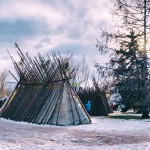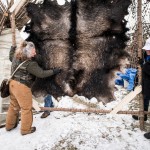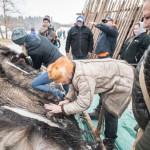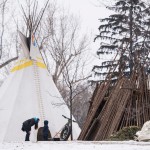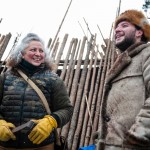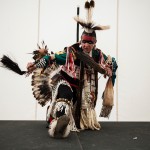Beginning with 2016’s edition of Silver Skate, festival-goers have enjoyed a new heritage experience down in Hawrelak. The Heritage Village Project created three Indigenous winter experiences including a winter hunting camp, a Métis camp and a winter tipi, allowing Silver Skate to build community around sharing Indigenous stories with Edmontonians.
We caught up with Creative Director Ritchie Velthuis to find out what they learned throughout the project and what Edmontonians can expect at this year’s festival.
- Silver Skate’s Indigenous Heritage Village Project. Photo: Marc J. Chalifoux
Describe your project in five words.
Interpretations of Indigenous Winter Shelters.
What gave you the idea for the project?
Indigenous culture is an important part of telling Edmonton’s story; sharing an authentic Indigenous story of what it might be like to have lived on the plains.
What challenges did you face—and what did you learn—throughout the project?
Sharing the same challenges as our Indigenous ancestors, the collection of materials in harsh winter conditions was a laborious task. Permission and protocols to harvest materials from the Paul Band were negotiated through Indigenous/Métis cultural coordinator Melissa Jo Belcourt-Moses, while other harvest sites were sourced out by Creative Director Ritchie Velthuis.
It was also important to us that the project had an Indigenous/Métis voice and working with individual voices can also be a challenge. Everyone has their own interpretation of winter structures and we had many discussions to ensure that we had the most authentic interpretation of indigenous winter structures of the Edmonton Region.
- Photo: Marc J. Chalifoux
- Photo: Marc J. Chalifoux
- Photo: Marc J. Chalifoux
- Photo: Marc J. Chalifoux
In your opinion, what are the greatest successes and impacts from the project in the community?
Perhaps our biggest measure of success was the notable increase in Indigenous and Métis people experiencing and visiting the encampments at the festival. Many discussions were generated through the encampment and not everyone agreed with each interpretation. As an example, one Indigenous observer did not feel that the weaved fence around the tipi was authentic to the local experience. Melissa Jo Belcourt-Moses, our Indigenous/Métis cultural coordinator, pointed out during their discussion that there is historical documentation that these structure were used to provide much needed protection during our long prairie winters.
During our “Everything Under the Rainbow” evening, a father and son from the Two Spirit Society performed a healing drum circle in honour of his aunt who identified as a lesbian and faced much adversity and hardship within her community as a result of her orientation. A brief introduction and song was followed by a smudge ceremony for all those gathered and the healing drum circle was performed. Because of the location of the winter encampments, this ceremony did not take place within the Indigenous/Métis Winter camp but during a visit to the encampment afterward the drummer and his son observed the positive power they felt within the space and were excited by the possibility to perform the ceremony there at the next Silver Skate Festival.
- Photo: Marc J. Chalifoux
- Photo: Marc J. Chalifoux
- Photo: Marc J. Chalifoux
Do you have any future plans to continue the work of the project? How can people become involved?
Infrastructure for the three Indigenous and Métis Winter Camps created has been stored and will be featured at future Silver Skate Festivals. This place making experience will allow us to continue to engage the public and continue to tell Indigenous/Métis stories that will benefit and inform the Edmonton community. In 2017 the winter encampment and Heritage stage will be moved closer to the other programming at the festival to ensure more people to experience this unique installation.
As previously mentioned, the mounting of these winter structure are a laborious task and we will be inviting volunteers to help with this process.
What advice do you have for individuals or organizations in Edmonton looking to undertake projects that share Edmonton’s story?
Be sure that it is an authentic Edmonton story that you are passionate about and will inspires others. Involve as many people as possible to ensure a well round perspective. Do not be committed to a specific path to your end objective as many great ideas will be presented through the project that will improved and enhance the end project.
